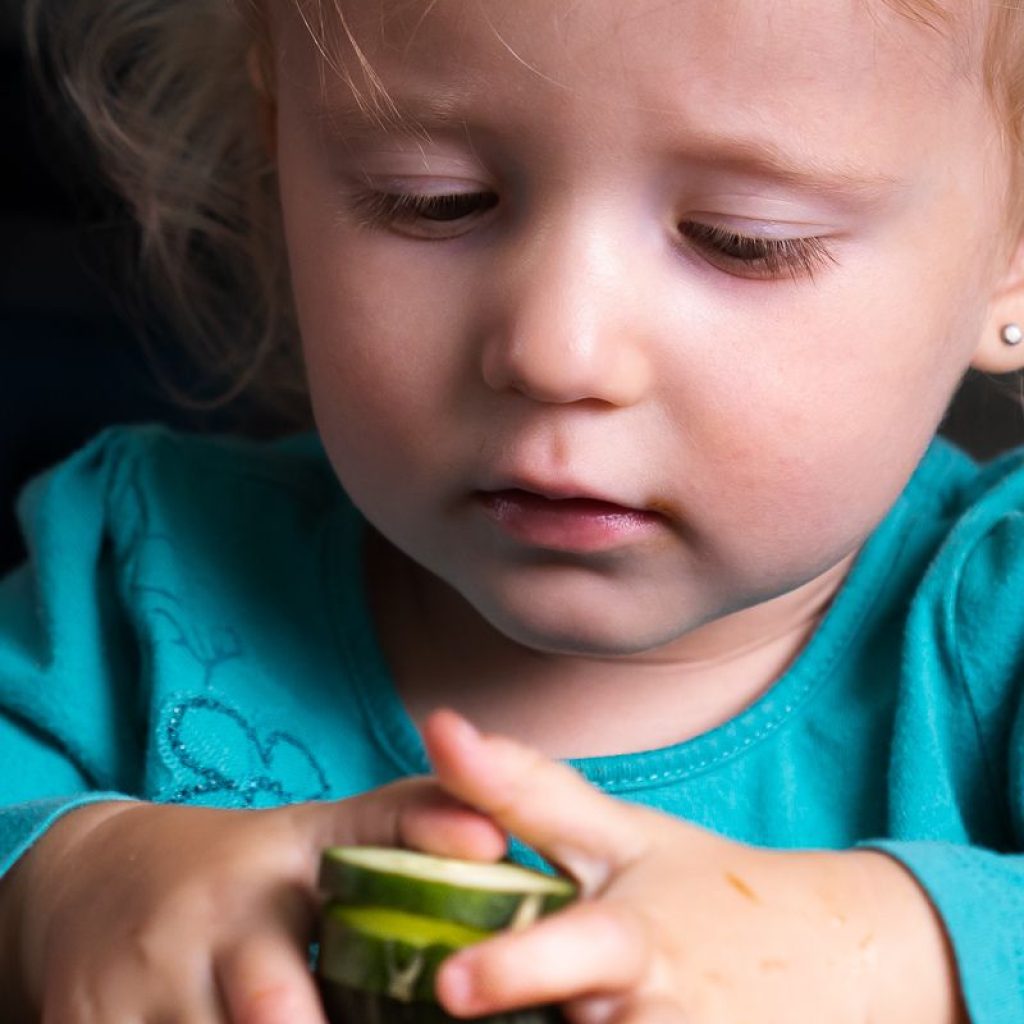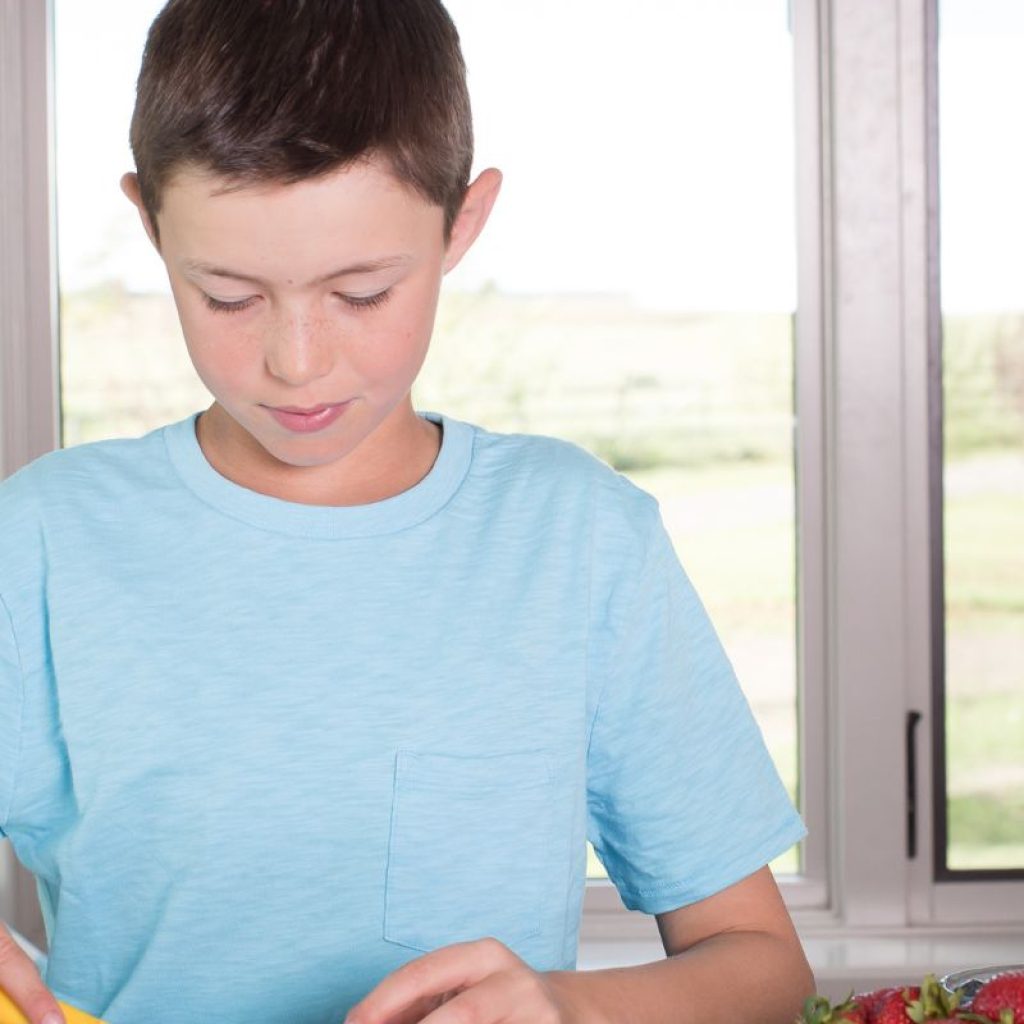If you’re a parent of a picky eater, you’ve probably tried it all to get your child to eat a balanced diet. Bribes, rewards and pleading…all to no avail.
As a dietitian and mom of three (one past picky eater!), I understand the anxiety that comes along with mealtime battles. And the concern that your child isn’t getting the nutrients they need to grow to their potential.
And vegetables often top the list of nutritious but-refused foods by kids. In this blog, I’ll share 10 tips to encourage your child to branch out and learn how to enjoy fruits and vegetables for a lifetime!
About Fruits & Vegetables for Kids
We all know fruits and vegetables are necessary for good health. We’ve heard the “half your plate” guidelines and have seen Canada’s Food Guide plate full of produce.

Fruits and vegetables provide fibre, antioxidants, vitamins, and minerals. This is why parents get so concerned when their child avoids this food group altogether! If your child doest eat fruit or vegetables, I recommend seeing a dietitian. They can do a personalized diet analysis and recommend supplements to fill the gap temporarily.
More common is for kids to like fruit and NOT vegetables. It’s great news if your child does eat fruit – because they can get the required nutrients without vegetables! This is because fruit and veggies contain many of the same nutrients. For example, folate, vitamin C, and fibre are found in both fruit and vegetables.
Not that you should give up offering vegetables. But knowing this might help you relax and decrease stress around the table.
Why do kids hate vegetables?
If you’re feeding a picky eater, vegetables are among the most challenging foods for young kids.
Around age 2, when children become more mobile, they also start to become “neophobic” or fearful of some new foods. This is possibly a defence mechanism to prevent new crawlers from shoving poisonous plants into their bodies!
The taste and texture of vegetables can also be a challenge. Vegetables are more naturally bitter. Kids naturally prefer sweet foods. This is natural because sweet foods provide quick energy sources (like sugar and refined carbs!) And hard crunchy vegetables can also be tougher to physically chew.
Don’t hide, bribe, or “educate” young kids to eat their veggies
The vast majority of parents use pressure to get their child to eat. Yet many research studies show that higher pressure to eat leads to lower levels of child food intake and weight and higher levels of pickiness. So pressure backfires. And maybe you can relate to still hating certain vegetables just because you were forced to eat them as a child!
Some forms of pressure are obvious – having to clean your plate or eating your vegetables before having seconds of other foods or leaving the table. Here are a few examples of more subtle pressure tactics to also steer clear from.
1. Avoid praise or rewards
“I’m proud of you for trying that new fruit,”
“What a big boy or girl.”
“You ate your vegetables – add a sticker to your sticker chart.”
As for praise – if your child knows you’re super happy because they ate vegetables, they know you’re unhappy if they don’t eat vegetables. Even if you don’t say so.
Our kids shouldn’t eat for a reward or approval but because they’re hungry. Research shows reward and praise lead to kids enjoying that food less anyways.
2. Bribes backfire
If your child has to finish their veggies to get dessert, this tells them that veggies are gross. And puts the dessert up on a pedestal, and it becomes even more desirable. Likely creating a sweet tooth, possibly for life – not our desired outcome!
3. Nutrition education doesn’t work
“Popeye eats spinach and he’s strong!”
“Carrots help you see better!”
“You need vitamin C in this orange to prevent catching a cold!”
We’ve all done it…. assumed that telling a child something is good for them will encourage them to eat it. But the research shows just the opposite. Preschoolers ate fewer carrots and crackers and rated them less tasty when caregivers told them that eating those foods would help achieve a specific health goal. So don’t bother!
4. Avoid hiding pureed vegetables in other foods
Sneaking pureed vegetables into your children’s food is a common tactic to trick them into eating it. It is great to boost the nutrition in food with vegetables! But I want your child to know that this is a chocolate zucchini muffin or that spinach makes the smoothie green.
Hiding the food doesn’t allow your child to experience that particular food. And to learn to like it on their own. Besides, they will probably figure it out at some point – busted! And they will refuse to eat that food and be wary of all foods you offer.
10 Tips for Getting Fussy Eaters to Eat Vegetables
Now that we’ve discussed common tactics that do NOT work to encourage kids to eat and enjoy new foods…here are 10 tips that DO work!
1) Make vegetables easier to eat
Kids love french fries and chips! So serve veggies shaped like a chip or fry. You can use a mandolin to make ‘chips’ with sweet potatoes, parsnips or beets. Drizzle them with oil and salt and bake. And kale chips are a great method to introduce this dark green vegetable to your kids in a form that might get eaten!
You can also try serving vegetables at different levels degrees of “done-ness”. Some children might prefer their corn frozen out of the bag, their carrots only raw, peas cooked to mushy, or potatoes mashed for example. Freeze-dried or frozen is often easiest to eat if your child is sensory sensitive. This is because the texture doesn’t change as much as fresh produce, which may change from bite to bite.
2) Add flavour
Celery tastes better with peanut butter, and carrots taste better with dip. Sure, you may get your child licking off the dip…..at least they’re putting the vegetable into their mouth! Hummus, yogurt dip, or even Ranch or Ketchup are fine.
And try roasting veggies to bring out the sweetness. My kids won’t touch brussel sprouts unless roasted with butter and maple syrup. Yum! Check out the Half Your Plate Flavour Guide for more ideas on making your veggies taste even better.
3) Give vegetables fun names
If you give a fruit or vegetable a catchy name, children are more likely to eat them. And eat more of them. Rainbow fruit salad, power peas, superhero spinach or broccoli as “mini-trees” might create some interest.
4) Play with food

Food play can be especially helpful if you have a sensory-sensitive child who doesn’t like certain textures. It gives them a chance to play and feel the food. And it’s another way to expose your child to food – with zero pressure to eat it, as it’s not time to eat!
Pinterest has never-ending ideas for food art or food play. For example, make a stamp with a beet or potato: cut it in half, cut a little shape out of it, and dip it in child-safe paint.
It can help to work with an occupational therapist specializing in feeding or a dietitian trained in the Sequential Oral Sensory method (SOS) to implement feeding therapy or a food play plan at home.
In SOS therapy, the child is presented with a piece of food to play with, one at a time. Sensory properties link all foods, and fun activities help work them up the ‘steps to eating.’ From being present with food to interacting with it, smelling, touching, tasting and eating it.
5) Don’t give up
Children can have a fear of new things, called “neophobia.” They also have changing tastes. It may take up to 15 (or more!) tries before your child will choose to eat the food. So offer the food whenever you are eating it. And don’t write it off as “he doesn’t like that, so I won’t serve it to him anymore.”
6) Serve veggies when hungriest
Just like any of us – food tastes better when we’re hungry! And we are less selective in what we will choose to eat. Your child may come home from school hungry or you could offer a veggie plate with dip as an “appetizer” during the witching hour before dinner.
7) Grow a garden and shop with your child
Involving kids in the process of growing or buying vegetables all counts as positive food exposure! And it will encourage them to taste the food.
Grow a garden (or even a windowsill pot) of vegetables. Visit the farmer’s market and talk to a farmer about how they grow their carrots. Or ask your child to pick out a new vegetable to try at the grocery store.
8) Cook with your child
Creating meals in the kitchen gives kids a sense of pride and ownership of the food. Your child will be more likely to try a new food they helped make. Here are some tips to include your child in the kitchen.

Many children don’t like the feel of certain textures or getting messy if they’re sensory sensitive. Cooking with your child exposes them to foods they typically avoid at mealtime. But it’s not mealtime…..so there’s no pressure to eat. As with food play, cooking gives your child extra exposure, and they may be more willing to touch these ingredients that they usually wouldn’t at the table.
9) Try Food Chaining
Food Chaining is another way to encourage children to try new food. It takes a favourite and a goal food and adds foods in between as a “chain.” All foods are similar because there’s just one different sensory property (like colour, shape or texture).
For example, if your child loves strawberry fruit roll-ups, our goal food might be fresh strawberries. We could first try offering strawberry fruit leather. Once that’s accepted, offer freeze dried strawberries and then fresh. For more details on how Food Chaining works, check out this blog.
10) Be a good role model
Let your child see you eat fruits & veggies – and your kids will eat more themselves! Parents who role model eating fruits and vegetables have children who eat more of them. You can also try offering new food with other children around, as kids like to copy each other.
Recipes to get kids to eat vegetables
As we know, vegetables need to be served in a tasty and easy way for kids. And it doesn’t have to be complicated, either. Store some ready-to-eat vegetables chopped in the fridge with Ranch dip as an appetizer before supper. Or for a picky toddler or preschooler- maybe they’d eat frozen peas or corn plain, despite refusing them in the cooked form!
Here are a few recipe ideas that might entice your kids to smell, lick, taste or eat the vegetables.
- Broccoli is the classic food that kids don’t like. But give these recipes a try: broccoli mac and cheese or Quick broccoli and cheddar muffin tin frittata.
- Leafy greens are tough for kids to eat. Instead, try this Chocolate Chip Spinach Banana Bread.
- Smoothies are another good way to get in extra fruits and vegetables, and often easier to consume. Remember, don’t “hide” that spinach – get your child to throw it in and make a green monster smoothie!
- Salads can be tricky too. Try a leafless salad like this Beet Salad or Greek Salad. Your child can pick out the pieces they want to eat. Even if it’s just the cheese for now, at least it counts as an extra exposure to cucumbers and tomatoes.
What if fruits and veggies come home from school untouched?
Maybe your child is ok with eating produce at home, but it always comes home from school uneaten. Here are a few tips to encourage your child to eat their fruits and veggies at school too.
1. Make them easy to eat
Think finger food. Cutting everything up into bite-sized pieces makes it more appealing, less overwhelming and quicker to eat. A sliced apple will get eaten over a whole apple every time! Even better – sprinkle it with a bit of lemon juice to prevent browning and cinnamon for flavour.
2. Include small amounts
To prevent waste and overwhelm on your child’s part, include very small amounts. Like one slice of bell pepper or 2 mini carrots.
3. Offer uneaten fruits and veggies as an after-school snack
If veggies come home uneaten because your child didn’t have time or wasn’t hungry, maybe they are hungry when they get home from school and will eat them happily.
But I wouldn’t force this with: “You have to finish everything in your lunch before you choose another snack.” As we learned above, pressure doesn’t help children to enjoy new foods.
4. Get your child involved
Ask your child what fruit or veggie they want to add to their lunch kit. Or better yet, get them to help make their lunch (or do it on their own, if old enough). Maybe they’d prefer dried or freeze-dried fruits or veggies, especially if your child is sensitive to texture or fruit that might go “mushy” in their lunch kit!
Conclusion – If your child refuses to eat fruits and vegetables
Avoid the pressure, praise, and bribes. Rry a new recipe and get your kids in the kitchen instead! The best thing you can do to teach your kids to enjoy fruits and vegetables is to expose them to them repeatedly, without pressure. This infographic does a great job of summarizing the tips to raise a fruit and veggie lover!
Ultimately if you remember that it’s not your job as a parent to get your child to eat their broccoli at dinner tonight, but to raise them with a healthy relationship with food it should all work out!
Bio
Jennifer House is a Registered Dietitian, mother of 3, author of “The Parents’ Guide to Baby-led Weaning” and founder of First Step Nutrition in Calgary, Alberta.

Jen believes raising happy, well-nourished eaters who have a healthy relationship with food doesn’t have to be a battle! She specializes in picky eating and helps parents teach their kids to try new foods without yelling, tricking, or bribing.



